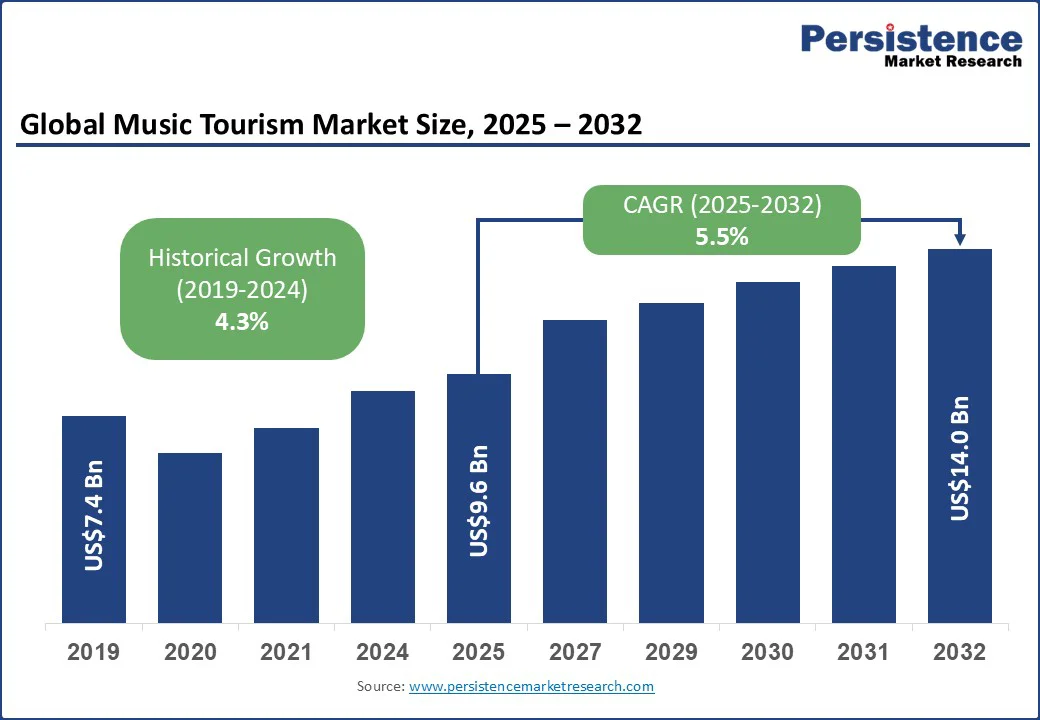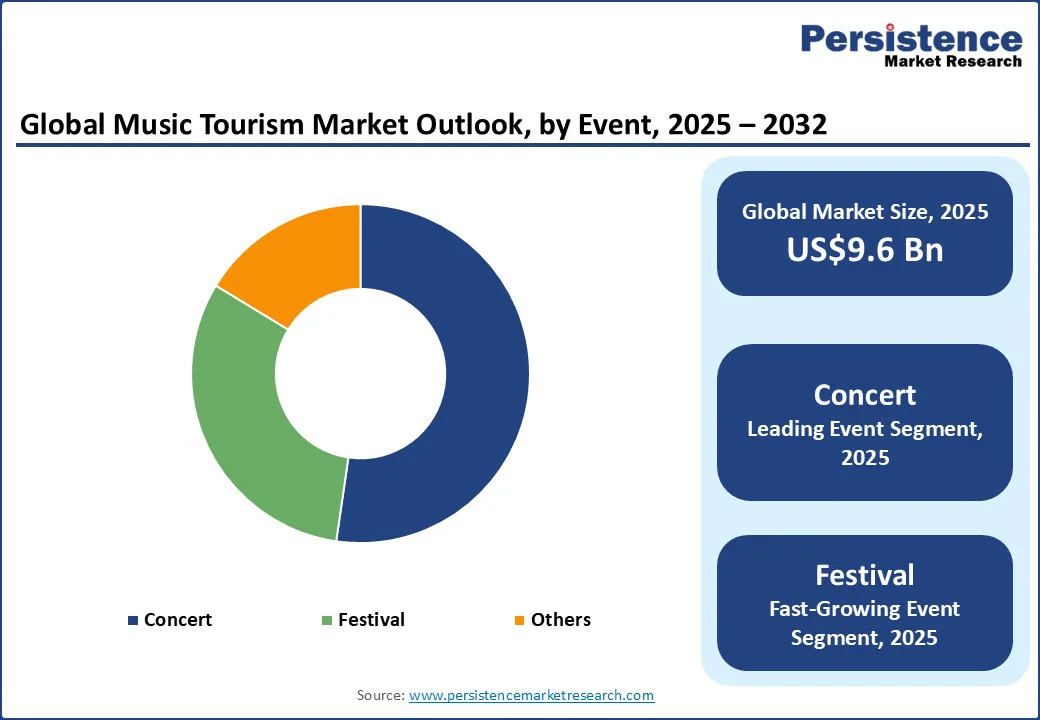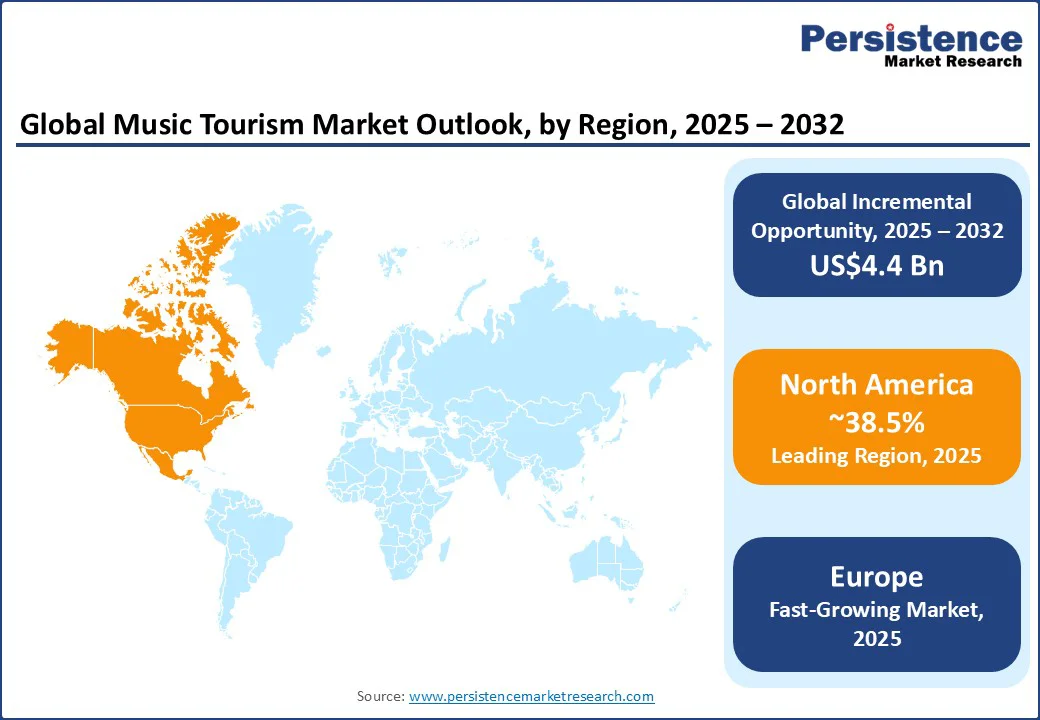ID: PMRREP35657| 192 Pages | 24 Sep 2025 | Format: PDF, Excel, PPT* | Consumer Goods

The global music tourism market size is likely to be valued at US$9.6 Bn in 2025 and is estimated to reach US$14.0 Bn in 2032, growing at a CAGR of 5.5% during the forecast period 2025-2032, powered by demographic shifts, the mainstream appeal of live music events, digital transformation in travel booking, and rising disposable incomes in emerging markets. It is also propelled by experiential travel trends and cross-industry partnerships, even as supply chain challenges and regulatory factors pose persistent hurdles.
Key Industry Highlights

| Key Insights | Details |
|---|---|
|
Music Tourism Market Size (2025E) |
US$ 9.6 Bn |
|
Market Value Forecast (2032F) |
US$ 14.0 Bn |
|
Projected Growth (CAGR 2025 to 2032) |
5.5% |
|
Historical Market Growth (CAGR 2019 to 2024) |
4.3% |
Music festivals such as Coachella, Tomorrowland, and Glastonbury have shifted from regional gatherings to massive international events. These flagship occasions attract millions, driving up tourism-related demand and stimulating local economies.
As organizers extend global reach, destinations capitalize on musical heritage and iconic events, bolstering overall industry growth. According to industry associations, festival attendance worldwide now accounts for over 50% of music tourism trips annually.
The proliferation of Online Travel Agencies (OTAs) and digital marketing amplifies music tourism's accessibility. Social media platforms and virtual engagement tools enable events and artists to reach global audiences.
Real-time sharing of content and streamlined booking processes result in swift conversions, measurable by a 20% annual increase in online bookings for music trips in 2024, as documented by a new study. The rise of virtual concerts and hybrid experiences extends market reach beyond geographic constraints.
Pandemic-related shutdowns, travel restrictions, and changing health protocols have disrupted mass event scheduling and attendee mobility. The financial and operational volatility caused by these disruptions remains a structural challenge, with festival organizers reporting a risk-adjusted attendance reduction of up to 15% since 2020.
Shifting government regulations across countries, including visa restrictions, crowd size limits, and mandatory vaccination requirements, introduces additional complexity for international touring artists and event organizers. Political instability and sudden changes in public policy can result in last-minute cancellations or postponements, increasing insurance and operational costs. Economic downturns in key markets further exacerbate uncertainty, affecting sponsorship deals, ticket sales, and ancillary revenue streams.
Large-scale events create challenges around carbon emissions, waste management, and local resource depletion. Regulatory bodies and industry associations require strict compliance, which raises costs and operational complexity. Events failing to meet sustainability standards face reputational risks and audience attrition.
Organizers are hence adopting green practices such as renewable energy-powered stages, zero-waste initiatives, and sustainable sourcing for food, merchandise, and event materials. Partnerships with environmental NGOs and the use of carbon offset programs help mitigate the ecological footprint while improving brand image. Attendees are also becoming more eco-conscious, with a surging preference for festivals and concerts that demonstrate clear sustainability commitments.
Rising income levels in regions such as Asia Pacific and Latin America allow broad participation in international music events. Governments promote national and regional festivals, embracing music culture to boost tourism arrivals. Increasing smartphone penetration and affordable streaming services make global music more accessible, encouraging cross-cultural exposure and participation.
Social media platforms increase awareness of live concerts and virtual music experiences, pushing demand for ticketed events and merchandise. Collaborations between international and local artists create unique experiences, attracting both domestic and foreign audiences. In addition, investments in novel venues and festival infrastructure improve the quality of live performances, making emerging regions attractive destinations for music tourism.
Destinations developing genre-specific or heritage-oriented tours and festivals can attract untapped market segments. Multi-genre and cultural festival integration increases tourist arrivals, with localized programming raising secondary city profiles. NexGen festival strategies are projected to rise at 8 to 10% per annum.
Collaborations with local artists, cultural institutions, and community groups enrich the authenticity of these niche experiences. These appeal to tourists seeking more meaningful and personalized engagement. Curated travel packages that combine music events with culinary tours, historical site visits, and hands-on workshops create holistic experiences, encouraging long stays and high per-visitor spending.
Concerts are expected to dominate the market with around 52.3% share in 2025, due to their broad international appeal and scalable event formats. Major acts and tours, supported by robust ticketing platforms, fuel global demand for both destination and local concert tourism.
Festival tourism is expected to outpace concerts in terms of CAGR, propelled by the preferences of millennials and Gen Z for multi-day immersive experiences. The segment benefits from the proliferation of themed and regional festivals, with growth exceeding approximately 19.1% CAGR in Asia Pacific and Latin America in the forecast period.
The 18 to 34-year age group is likely to comprise nearly 65.4% of music tourists in 2025, augmenting market volume through travel-based concert and festival attendance. Their adoption of digital booking platforms and cross-border event participation sets market trends.
The 34 to 54 years segment is witnessing accelerated growth at an estimated CAGR of 19.6%, propelled by nostalgia-driven travel and loyalty to legacy artists and festivals. They represent a key audience for destination and heritage events.
Online travel agencies are projected to account for approximately 57.7% of music tourism bookings in 2025 due to streamlined service integration. OTAs provide bundled event and travel packages, attracting tech-savvy travelers seeking convenience and cost efficiency.
Direct bookings are seeing rapid adoption, attributed to personalized offers and cost-saving incentives for travelers who prefer exclusive event experiences. The segment’s CAGR is projected to surpass 19.0% between 2025 and 2032.

North America is expected to lead the market, accounting for approximately 38.5% of the global share in 2025. The U.S. is dominant, comprising nearly 75% of regional volume, with growth supported by iconic festivals such as Coachella and Lollapalooza, diverse venue infrastructure, and regulatory initiatives, including the American Music Tourism Act. High spend per tourist, new ticketing solutions, and stable event calendars shape business outcomes. Canada’s live music generated US$10.92 Bn in GDP, supporting over 101,000 jobs in 2023.
Cultural legacy, integrated travel/event solutions, and robust innovation in live event production are further influencing the regional market. Stable oversight, competitive tax policies, and significant federal or state investment in tourism are also fueling growth. Consolidated market leadership, active industry associations, and ongoing investments in venue upgrades, as well as digital platforms, are creating fresh opportunities.
Europe is predicted to hold about 30.3% of the global market share in 2025. Leading countries include Germany, the U.K., France, and Spain. Dublin ranks fourth in Europe for live music, hosting over 558 gigs annually. Eurovision regularly draws up to 60,000 attendees per event. Post-pandemic demand, historical music cities, and harmonized EU travel regulations contribute to market resurgence.
Compliance with sustainability standards and coordinated festival schedules boost cross-border travel. Europe has a fragmented industry structure with the presence of several local and regional players. Investment in venue and infrastructure modernization ensures continued growth.
Asia Pacific is expected to post the highest projected CAGR, estimated at 19.5% between 2025 and 2032. Market leaders include China, Japan, India, and ASEAN countries. Events such as Ultra Music Festival and Fuji Rock catalyze inbound tourism, while Taylor Swift’s regional tour in 2024 sparked flight and accommodation demand spikes of over 44% and 446% in Australia.
Expanding middle class, digital booking adoption, and government-backed festival initiatives are fueling growth. Strategic government and private sector investment in event infrastructures creates new avenues. Emerging local and global partnerships, as well as steady growth in music-themed travel product innovation, are likely to spur the regional market.

The global music tourism market is moderately fragmented, with leading players holding significant market influence. Market concentration is higher in North America and Western Europe due to well-established festivals and corporate event management firms.
Major market leaders drive differentiation through innovation, cost leadership, bundled travel or event solutions, and market expansion. The emergence of hybrid and experiential tourism models exemplifies modern trends.
The music tourism market is projected to reach US$9.6 Bn in 2025.
The integration of local heritage with live events and the growth of niche festivals are the key market drivers.
The music tourism market is poised to witness a CAGR of 5.5% from 2025 to 2032.
Expansion into untapped regions and sustainable music tourism initiatives are the key market opportunities.
Coachella Valley Music & Arts Festival, Lollapalooza, and Tomorrowland are a few key market players.
| Report Attribute | Details |
|---|---|
|
Historical Data/Actuals |
2019 - 2024 |
|
Forecast Period |
2025 - 2032 |
|
Market Analysis |
Value: US$ Bn |
|
Geographical Coverage |
|
|
Segmental Coverage |
|
|
Competitive Analysis |
|
|
Report Highlights |
|
By Event
By Age Group
By Booking Mode
By Region
Delivery Timelines
For more information on this report and its delivery timelines please get in touch with our sales team.
About Author